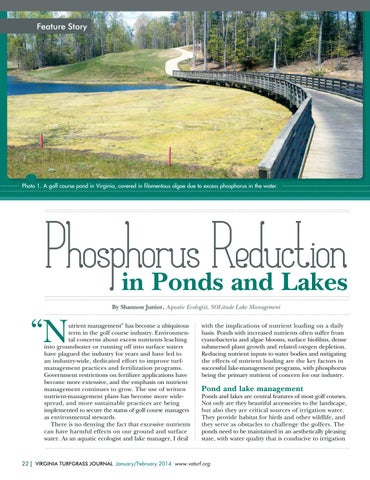Feature Story
Photo 1. A golf course pond in Virginia, covered in filamentous algae due to excess phosphorus in the water.
Phosphorus Reduction
in Ponds and Lakes
By Shannon Junior, Aquatic Ecologist, SOLitude Lake Management
“N
utrient management� has become a ubiquitous term in the golf course industry. Environmental concerns about excess nutrients leaching into groundwater or running off into surface waters have plagued the industry for years and have led to an industry-wide, dedicated effort to improve turfmanagement practices and fertilization programs. Government restrictions on fertilizer applications have become more extensive, and the emphasis on nutrient management continues to grow. The use of written nutrient-management plans has become more widespread, and more sustainable practices are being implemented to secure the status of golf course managers as environmental stewards. There is no denying the fact that excessive nutrients can have harmful effects on our ground and surface water. As an aquatic ecologist and lake manager, I deal
with the implications of nutrient loading on a daily basis. Ponds with increased nutrients often suffer from cyanobacteria and algae blooms, surface biofilms, dense submersed plant growth and related oxygen depletion. Reducing nutrient inputs to water bodies and mitigating the effects of nutrient loading are the key factors in successful lake-management programs, with phosphorus being the primary nutrient of concern for our industry.
Pond and lake management
Ponds and lakes are central features of most golf courses. Not only are they beautiful accessories to the landscape, but also they are critical sources of irrigation water. They provide habitat for birds and other wildlife, and they serve as obstacles to challenge the golfers. The ponds need to be maintained in an aesthetically pleasing state, with water quality that is conducive to irrigation
22 | Virginia Turfgrass Journal January/February 2014 www.vaturf.org
